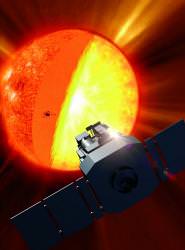One of the great risks of space travel is the threat from solar radiation storms. An unlucky group of astronauts traveling to the Moon could get caught unprotected as a hail of charged particles and radiation blast through the spacecraft. But now NASA researchers think the Solar and Heliospheric Observatory (SOHO) will be able to give astronauts some warning before the big storm hits.
SOHO is normally used for scientific observations of the Sun. But it’s equipped with an instrument called the Comprehensive Suprathermal and Energetic Particle Analyzer (COSTEP), which counts particles coming from the Sun, and measures their energies.
One of the main predictors are electrons, which aren’t dangerous in themselves, but are the first wave of a coming storm. The electrons are lighter than the other particles, so they’re carried out ahead of the heavier, and more dangerous particles. By analyzing hundreds of solar storms, the researchers were able to match electrons with a predicted density of ions.
When SOHO is experiencing one of these electron storms, astronauts traveling to the Moon will be experiencing it as well. And the more dangerous ions and heavier particles are about to arrive. This advance notice will allow the astronauts to retreat to a safer location in the spacecraft and ride out the storm, suffering the minimum radiation damage.
This technique was able to predict all 4 major storms in 2003, providing advance warnings from 7 to 74 minutes.
Original Source: NASA News Release

